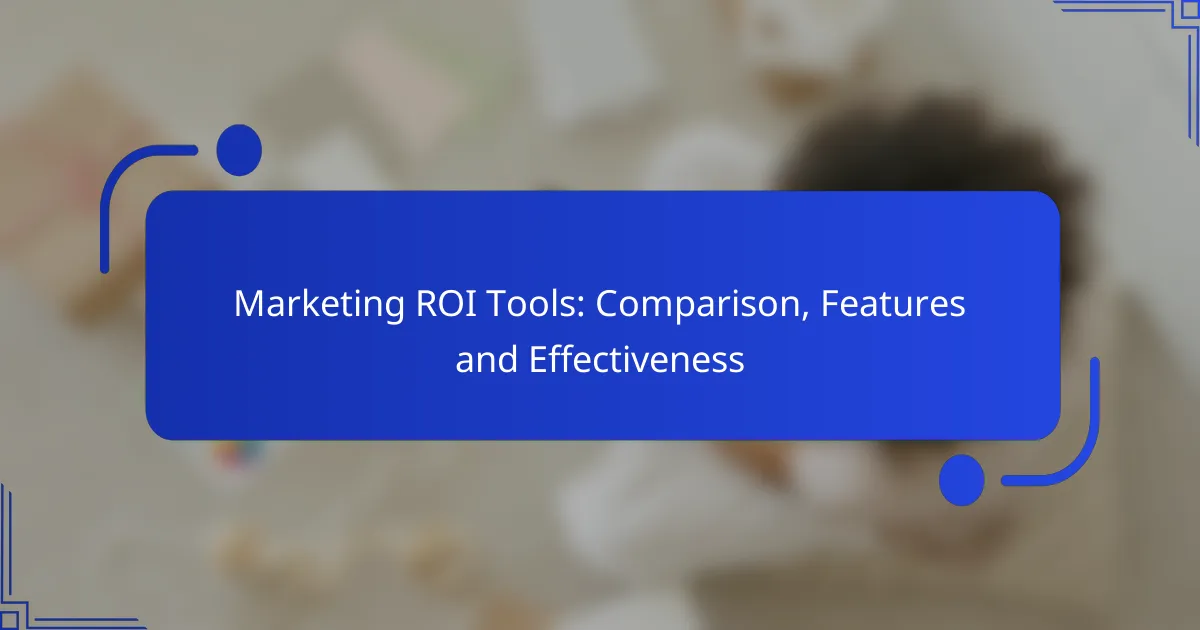Marketing ROI tools are essential for businesses aiming to evaluate the effectiveness of their marketing strategies through data analysis and actionable insights. With options like HubSpot Marketing Hub, Google Analytics, and Adobe Analytics, these tools offer diverse features that cater to different needs. By comparing analytics capabilities, integration options, and pricing structures, businesses can select the most effective tool to optimize their marketing efforts and improve return on investment.
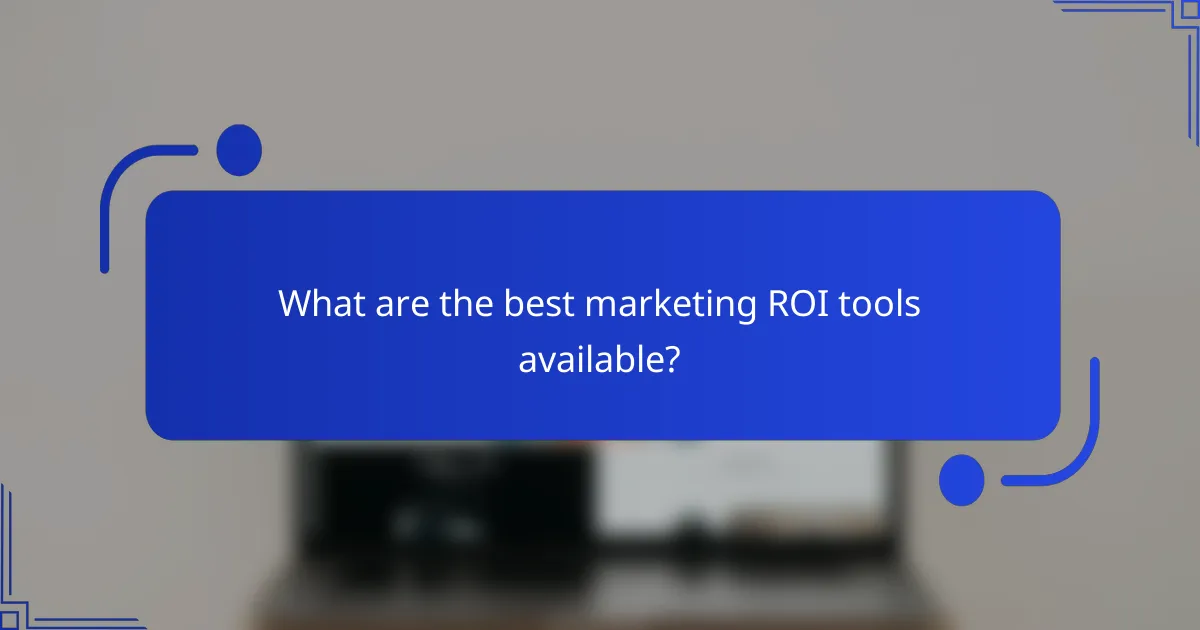
What are the best marketing ROI tools available?
The best marketing ROI tools help businesses measure the effectiveness of their marketing efforts by analyzing data and providing actionable insights. Key options include HubSpot Marketing Hub, Google Analytics, Marketo, Salesforce Marketing Cloud, and Adobe Analytics, each offering unique features and capabilities to optimize marketing strategies.
HubSpot Marketing Hub
HubSpot Marketing Hub is an all-in-one platform designed for inbound marketing, providing tools for content management, social media, and email marketing. It allows users to track ROI through detailed analytics, helping businesses understand which campaigns yield the best results.
Consider using HubSpot if you want a user-friendly interface and integrated features. Its pricing varies, with free tools available and paid plans starting from around $50 per month, depending on the features you need.
Google Analytics
Google Analytics is a powerful, free tool that tracks website traffic and user behavior, allowing marketers to assess the effectiveness of their online campaigns. It provides insights into user demographics, acquisition channels, and conversion rates, making it essential for data-driven decision-making.
To maximize its effectiveness, set up goals and conversion tracking. While the basic version is free, Google Analytics 360 offers advanced features for larger enterprises at a cost that can reach thousands of dollars annually.
Marketo
Marketo is a robust marketing automation platform that focuses on lead management and engagement. It offers tools for email marketing, landing page creation, and analytics, enabling businesses to measure the ROI of their marketing efforts effectively.
Marketo is ideal for medium to large businesses looking for advanced features. Pricing is typically customized based on the specific needs of the organization, often starting in the low thousands per month.
Salesforce Marketing Cloud
Salesforce Marketing Cloud provides a comprehensive suite of marketing tools that integrate seamlessly with Salesforce’s CRM. It enables businesses to create personalized customer journeys and track marketing performance across various channels.
This tool is suitable for organizations already using Salesforce, as it enhances data integration and customer insights. Pricing can be substantial, often starting at several hundred dollars per month, depending on the modules selected.
Adobe Analytics
Adobe Analytics offers advanced data analytics capabilities, allowing businesses to track customer interactions across multiple channels. It provides in-depth insights into user behavior and campaign performance, making it a strong choice for data-centric marketers.
Consider Adobe Analytics if you require sophisticated reporting and analysis tools. Pricing is typically on the higher end, often starting from several thousand dollars annually, reflecting its enterprise-level capabilities.

How do marketing ROI tools compare in features?
Marketing ROI tools vary significantly in features, impacting their effectiveness for different businesses. Key areas of comparison include analytics capabilities, integration options, user interface, and pricing structures, which can influence the overall value and usability of these tools.
Analytics capabilities
Analytics capabilities are crucial for measuring the effectiveness of marketing efforts. Tools with advanced analytics can provide insights into customer behavior, campaign performance, and return on investment. Look for features like real-time reporting, customizable dashboards, and predictive analytics to gain a comprehensive view of your marketing ROI.
For example, some tools may offer A/B testing features that allow you to compare different marketing strategies, while others may focus on multi-channel tracking to assess performance across various platforms. Prioritize tools that align with your specific analytical needs.
Integration options
Integration options determine how well a marketing ROI tool can work with your existing systems. Tools that offer seamless integration with CRM, email marketing, and social media platforms can streamline data flow and enhance overall efficiency. Check for compatibility with popular software like Salesforce, HubSpot, or Google Analytics.
Consider the ease of setup and the extent of data sharing between tools. A robust integration can save time and reduce errors, making it easier to track and analyze marketing performance across channels.
User interface
A user-friendly interface is essential for maximizing the effectiveness of marketing ROI tools. A clean, intuitive design can facilitate quicker learning and easier navigation, allowing users to access key features without frustration. Look for tools that offer customizable layouts and drag-and-drop functionalities.
Additionally, consider the availability of training resources, such as tutorials or customer support, which can enhance user experience. A good interface can significantly impact how effectively your team utilizes the tool to drive marketing decisions.
Pricing structures
Pricing structures for marketing ROI tools can vary widely, often based on features, user count, or data volume. Some tools offer tiered pricing plans, allowing businesses to select a package that fits their budget and needs. Expect to see monthly subscriptions ranging from low tens to several hundred dollars, depending on the complexity of features offered.
Evaluate whether the pricing aligns with the value provided. Consider any hidden costs, such as fees for additional users or premium features, and ensure that the tool’s capabilities justify the investment for your marketing strategy.
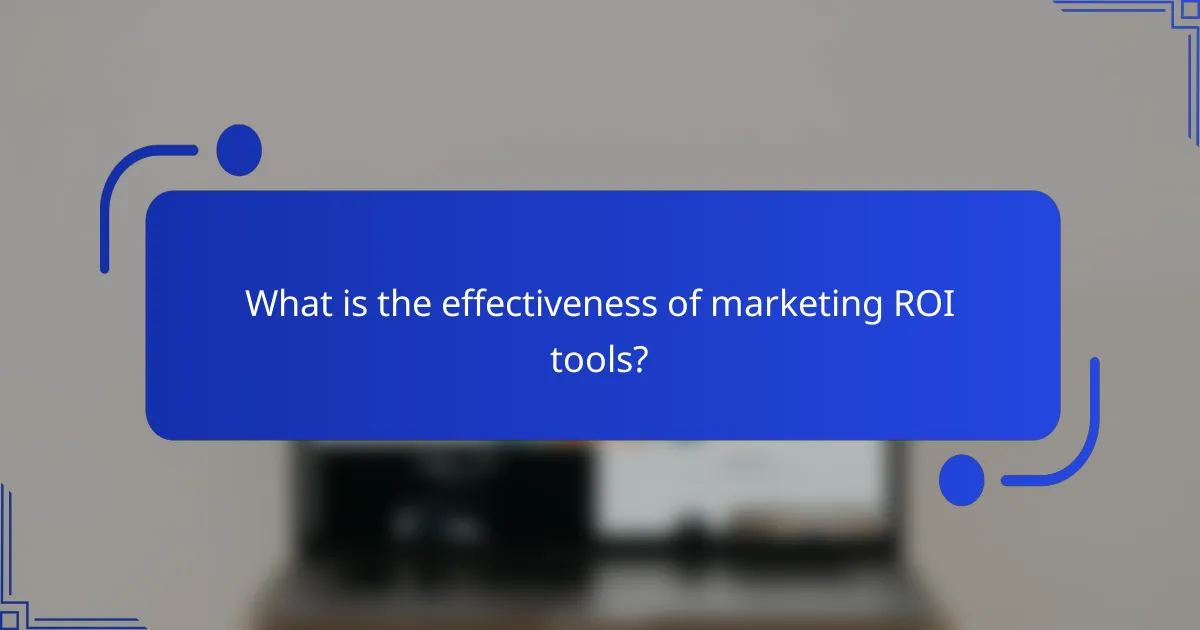
What is the effectiveness of marketing ROI tools?
Marketing ROI tools are effective in measuring the return on investment for marketing activities, helping businesses understand which strategies yield the best results. By analyzing data and performance metrics, these tools provide insights that can guide budget allocation and campaign optimization.
Case studies
Case studies demonstrate the practical application of marketing ROI tools across various industries. For instance, a retail company used an ROI tool to track the performance of its digital advertising campaigns, resulting in a 30% increase in sales attributed to targeted ads. Such real-world examples highlight how businesses can leverage these tools to make informed decisions.
Another example involves a SaaS company that implemented an ROI tool to analyze customer acquisition costs. By adjusting their marketing strategies based on the insights gained, they reduced their customer acquisition cost by nearly 25%, showcasing the potential for significant savings and improved profitability.
Industry benchmarks
Industry benchmarks provide a reference point for evaluating the effectiveness of marketing ROI tools. Many companies aim for an ROI of at least 5:1, meaning for every dollar spent on marketing, they expect to earn five dollars in return. However, this can vary widely by sector; for example, e-commerce businesses may see higher benchmarks compared to traditional retail.
Understanding these benchmarks allows businesses to set realistic goals and measure their performance against competitors. Regularly reviewing industry standards helps ensure that marketing strategies remain competitive and effective.
Customer testimonials
Customer testimonials often highlight the transformative impact of marketing ROI tools. Many users report improved clarity in their marketing efforts and enhanced decision-making capabilities. A marketing manager from a mid-sized company noted that using an ROI tool helped them identify underperforming campaigns, leading to a more focused and effective marketing strategy.
Another user emphasized the ease of tracking results over time, stating that the insights gained from the tool allowed them to pivot quickly and capitalize on emerging trends, ultimately boosting overall marketing effectiveness.
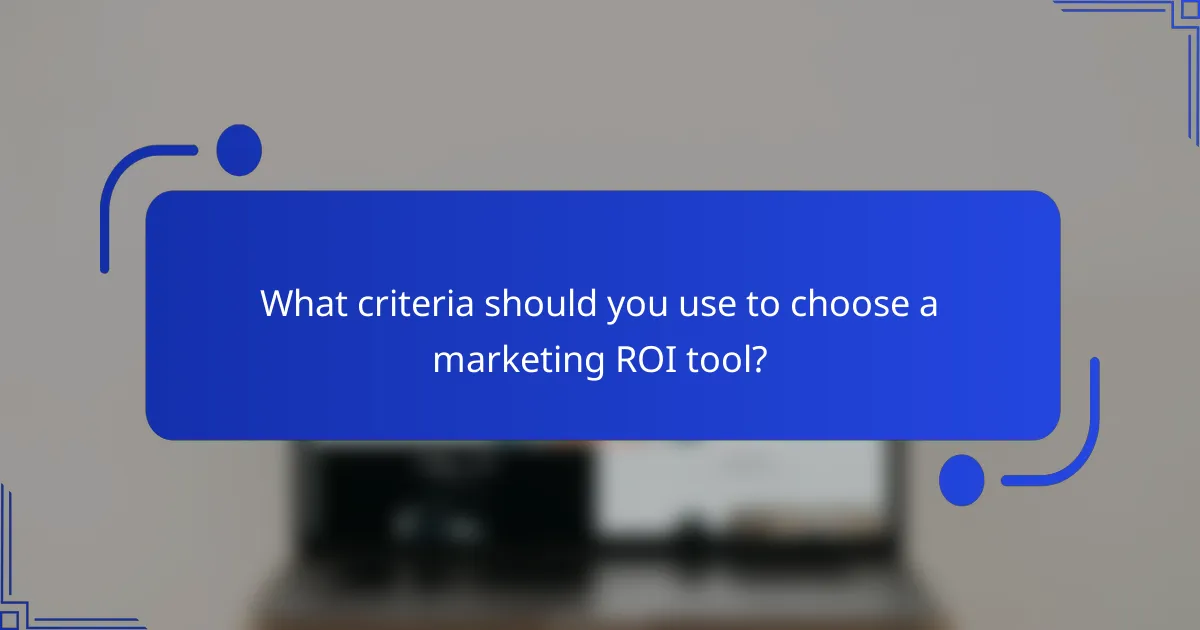
What criteria should you use to choose a marketing ROI tool?
Choosing a marketing ROI tool requires careful consideration of several key criteria, including business size, marketing goals, and budget. Each factor plays a crucial role in ensuring the selected tool aligns with your specific needs and objectives.
Business size
The size of your business significantly influences the type of marketing ROI tool you should choose. Small businesses may benefit from simpler, cost-effective solutions that provide essential tracking features, while larger enterprises might require more sophisticated tools with advanced analytics and integration capabilities.
For example, a small startup may opt for a basic tool that offers social media tracking, while a multinational corporation might need a comprehensive platform that integrates with multiple data sources and provides detailed reporting across various marketing channels.
Marketing goals
Your marketing goals are critical in determining the right ROI tool. If your focus is on brand awareness, look for tools that emphasize reach and engagement metrics. Conversely, if your goal is lead generation or sales conversion, prioritize tools that track customer journeys and conversion rates effectively.
Establishing clear objectives will help you select a tool that not only measures ROI but also aligns with your strategic vision. For instance, a company aiming to increase online sales should choose a tool that integrates with e-commerce platforms and provides insights into customer behavior.
Budget considerations
Budget is a vital factor when selecting a marketing ROI tool, as costs can vary widely based on features and capabilities. Determine how much you are willing to invest in a tool, keeping in mind that more expensive options may offer advanced features that could justify the cost in the long run.
Consider starting with a basic plan that allows room for upgrades as your needs grow. Many tools offer tiered pricing structures, so evaluate what features are essential for your current situation and what can be added later without significant financial strain.
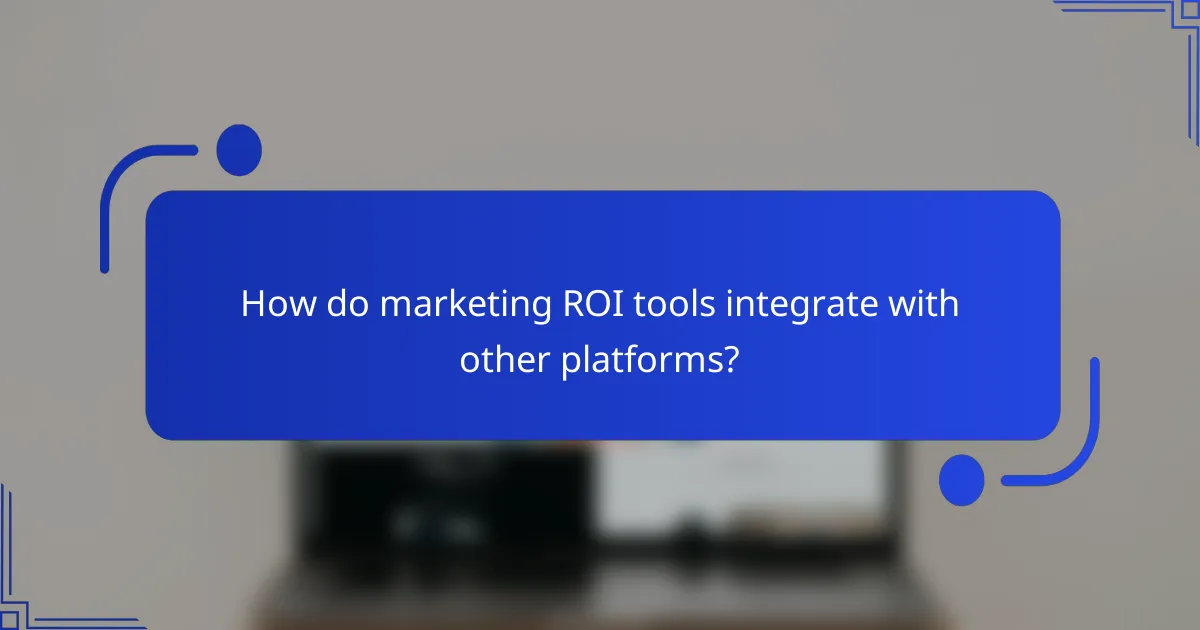
How do marketing ROI tools integrate with other platforms?
Marketing ROI tools often integrate with various platforms to streamline data collection and analysis, enhancing overall marketing effectiveness. These integrations typically involve connecting with customer relationship management (CRM) systems, analytics tools, and advertising platforms to provide a comprehensive view of marketing performance.
CRM integration
Integrating marketing ROI tools with CRM systems allows businesses to track customer interactions and measure the impact of marketing efforts on sales. This connection enables marketers to analyze customer data, segment audiences, and assess how different campaigns influence customer behavior.
When considering CRM integration, ensure that the marketing ROI tool can seamlessly pull data from your CRM. Look for features like automated data syncing, customizable reporting, and user-friendly dashboards that present insights clearly. Common CRM platforms like Salesforce or HubSpot often have built-in integrations with popular marketing ROI tools.
To maximize the benefits of CRM integration, regularly review the data flow and ensure that all relevant metrics are being captured. Avoid common pitfalls such as neglecting data quality or failing to update integration settings when changes occur in either platform.
